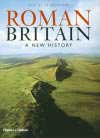

|
|
Britain after the Romans
Money
After the collapse of Roman rule, coin minting and the use of money appears to have ceased for some two centuries. Britain reverted to barter and a largely rural, moneyless economy. Glyn Davies (1996: 641) notes that "after the fall of Rome Britain showed the unique spectacle of being the only former Roman province to withdraw completely from using coined money for nearly 200 years...the absence of money reflected and intensified the breakdown of civilized living and trading."
However, in 1997, a hoard of 22 gold solidi, 25 silver coins or fragments of silver coins, 2 heavy gold rings and 50 small pieces of silver bullion dating to AD 333- c.461-70 was found at Patching, near Worthing, Sussex. The coins included two imperial coins from Ravenna (reign of Valentinian III) dated c. AD440+ and Visigothic coins from the reigns of Majorian (c. 460-1) and Libius Severus (c. 461+). The hoard was buried, possibly in advance of Saxon incursions, around AD475. This is evidence to show that earlier views were not correct and that Roman coins were still reaching Britain well into the 5th century. The older coins were heavily clipped, suggesting their use in circulatiion whereas the later coins were almost pristine. The find also implies that Romano-British institutions of a sort were still in existence in Southern England late in the 5th century.
'Roman' culture.
Agriculture had being going through a process of concentration in Britain, as in other parts of the Roman empire, for over a century. Some continuation of occupation at 'palatial' villa sites remained.
There is further evidence that 'Roman' culture lived on for several centuries in the west of Britain. See, for example, Centuries of Roman survival in the West by Ken Dark.
Certainly they carried on using Latin: Literate culture of `Dark Age' Britain by David Howlett.
Religion
Britain seems to have been heavily involved with the Pelagian heresy. According to Prosper this began in 413. By 418 Pelagianism had been outlawed in Rome but it continued to have considerable support in Britain, from the "pro-Celtic" faction. In 429 a British deacon, Palladius, requested that Pope Celestine send two representatives, bishops Germanus of Auxerre and Lupus of Troyes to Britain to combat the Pelagian heresy. Germanus, formerly a military commander, led Britons to the "Hallelujah" victory in Wales.
Tradition has it that St. Patrick's mission to Ireland began three years later in 432. He is known to have been born somewhere in Britain but was it Somerset? Locating the birthplace of St Patrick by Harry Jelley.
Provincial organization
Both Gildas and Nennius refer to a "concilium provinciæ", at which the means for providing for the defence of Britain was frequently discussed. However, by the middle of the century, around 440-50 civil war and famine spread through Britain as a result of the weakness of Britains rulers and their inability to defend the country from Pictish invasions. The conflict caused by the Pelagian heresy added to lack of unity.
From the other side of the channel, c.441, the Gallic Chronicle prematurely states that "Britain, abandoned by the Romans, passed into the power of the Saxons." In 446 the pro-Roman faction in Britain appealed to Aetius, Roman governor of Gaul, for help in the struggle against the Picts and Irish (Scots). Aetius could offer no assistance as he was defending Gaul against the armies of Attila the Hun.
The Annales Cambriae includes some 'factual' information which may be constructed from old records.
Around this time, later literature holds that Vortigern employed Saxon mercenaries, termed foederati, to defend his territory against barbarian attack. Cunedda and his sons were moved from Manau Gododdin (Lothian) to Gwynedd as a bulwark against the Irish. In Britain and the End of the Roman Empire (2000) Ken Dark dismisses this as a myth, along with many other notions about this period that have not been supported by recent archaeology.

Amazon.co.uk - British pounds
Amazon.com - US dollars
Amazon.ca - Canadian dollars
Amazon.de - Euros
Amazon.fr - Euros
Copyright © 2009-2025 Alan Price and IslandGuide.co.uk contributors. All rights reserved. Island Guide makes minimal use of cookies, including some placed to facilitate features such as Google Search. By continuing to use the site you are agreeing to the use of cookies. Learn more here